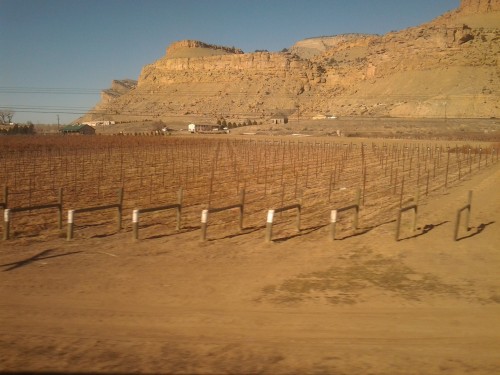January 31, 2012 —
I just returned from Colorado where I attended VinCO. The Colorado Association for Viticulture and Enology (CAVE), Colorado Wine Industry Development Board (CWIDB) and Western Colorado Horticulture Society (WCHS) put on this conference focusing on grape growing, winemaking, and issues pertinent to the business and marketing side of the fruit and wine industries. I came away with some great information and greater understanding of the challenges facing Colorado’s grape growers and wineries. Today, we’ll focus on one challenge that is common to most of The Other 46, but one that can be avoided in reaching profitability.
Colorado is overall a very rural state. The mountains provide great beauty, but they also create barriers to developing cities. Most of the population lies in a central area around Denver, up & down I-25. So, what does this mean for wineries and vineyards in Colorado and other less densely populated states when it comes to building a winery? Other states have their own access challenges, but access and location paramount when determining where to locate a boutique winery. We’ll use Colorado’s challenges here though.
Here are the challenges that small, out of the way, wineries are facing:
1. Wineries are too small for distribution and often no where near a city or major highway.
2. Vineyards are small due to the often mountainous terrain or available land.
3. Weather often prevents customers from getting to the winery.
There are two things a business needs to be successful: Positive Cash flow and Positive Return on Investment Interesting since the traditional method of establishing a winery typically doesn’t allow for positive cash flow, much less a positive ROI for several years. And by several, I mean a minimum of 5-6. Here’s the way most wineries with vineyards get started:
Year 1: Buy your land, vines, tractor, trellis, irrigation, fertilizers, etc and plant your vineyard. A good rule of thumb for vineyard establishment is a cost of $10,000 – 15,000 per acre, not including the cost of the land. For our discussion, let’s say a 25 acre vineyard and a loan of $300,000.
Year 2-3: Vineyard is growing. It costs about $3,000 per acre each year to maintain and grow the non-producing vines. Plus, in year 3 you take on a $2,000,000 debt to build your winery and tasting room, buy equipment, pay for utilities, etc. Now you need to employ 2-3 people to operate your winery, plus you have to pay yourself at minimum your living expenses. Tack on another $120,000 for employment. Now you have invested nearly $3,000,000.
Year 4: Vines produce 1/3 of their potential harvest. With 25 acres producing 1/3 of their full harvest, you can make 4500 gallons of wine. If you are growing several varietals, you will need separate tanks for each, which will be smaller than you need for full production. Cost per acre is now $4,000, and there are another $50,000 in capital investments for picking bins, bird netting, etc. (Reminder: You still have no income yet.) Total investment is $3,300,000.
Year 5: Vines produce 2/3 of their potential harvest. Now you have 9000 gallons of wine (assuming no problems with your grapes…it is likely you will have some problem that impacts your fruit) and you’ll need larger tanks. Also year 4’s wine is ready. That’s 4500 gallons, which is 1875 cases. Industry average shows that the typical small winery sells 1000 cases the first year. At $20/bottle, that’s $240,000 in gross income if you sell it all through your tasting room. By the way, you now need to hire a couple of people to run your tasting room too, so your payroll increases to $200,000, and $40,000 is not likely to be enough to cover other operation expenses in the winery.
Year 6: Vines produce a full harvest. Year 5’s harvest is ready to sell, which is about 3500 cases. You have 875 cases left over from year 4 for a total of 4375 cases in inventory. So far, you have sunk $3,750,000 investment in the business and you have sold 1000 cases in year 5. Best case scenario for year 6 sales is 2500 cases at $20/bottle = $500,000 in gross revenue, which is close to, or if you are lucky, a little better than break even for the year.
Year 7: You are producing wine at full capacity. You sell 4000 cases this year at an average $20/bottle for $960,000. Let’s say you’ve been able to pay off $750,000 in debt, leaving you $3,000,000 owed. It’s year 7!
Year 8-10: Sales are now the same as full production at 5500 cases per year. With an average price of $20/bottle (very unlikely at this volume of production, $15 is more likely) annual sales are $1,300,000. Within two years you break even and you are producing 5000-6000 cases/year. At this point you are worn out and completely exhausted, when all you really wanted to do was make wine.
THAT is the traditional method that many have done and continue to do. When choosing to start a winery, looking at the reality of actually generating positive cash flow is what no one wants to pay attention to.
So what other ways are there to get what you want without being in debt for 8+ years and completely drained from your dream?
Stay Tuned for Part 2: Three Ways to Produce Positive ROI in Half the Time or Less
Custom solutions for your winery. Finely crafted wine blends and consulting (because you’re not a Napa winery!)
Premier Wine Blends 888-767-7442 Email Us

Comments
Write a comment: